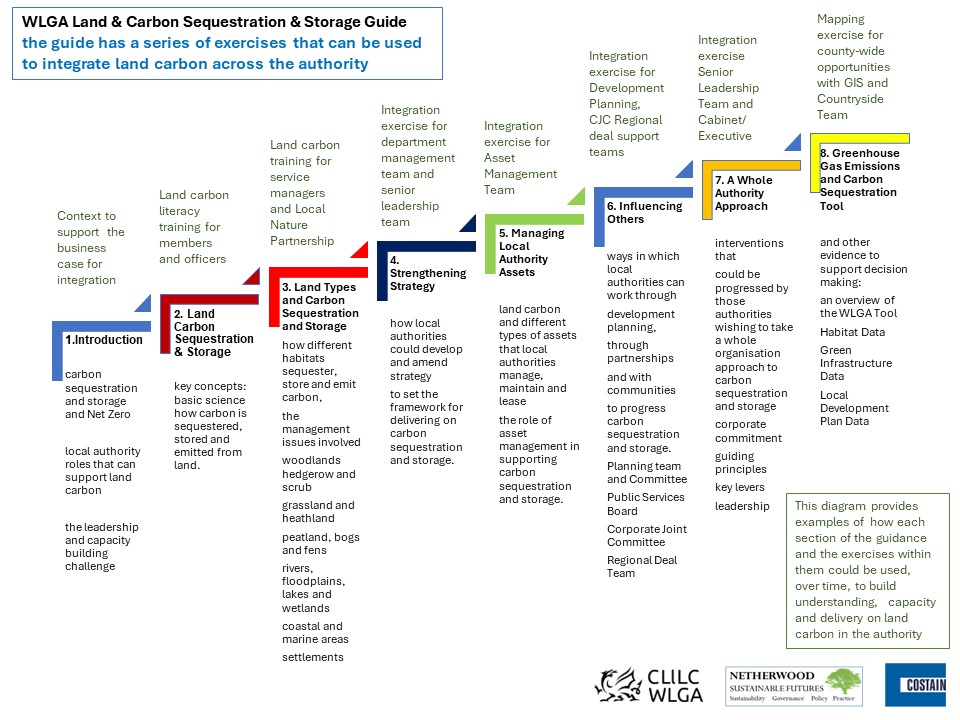The Land and Carbon Sequestration Mapping Tool is for council officers, elected members and local authority decision makers to:
- calculate land-based emissions for annual reporting.
- understand the land use emissions impacts of programmes, projects and land use change.
- calculate the carbon sequestered and emitted through different activities associated with land management.
The tool and guidance form part of a library of data sets and maps to support councils with understanding the carbon impact of their land and habitat types.
This guidance covers; key concepts; management approaches for different land types; strategic approaches; asset management; influencing others; and leadership; and a series of integration exercises for authorities to undertake.
This guide can help senior leadership teams, asset managers, planners, operational managers and elected members to integrate carbon sequestration and storage into their work.
It is important that local authorities can measure land-use emissions and carbon sequestration to inform decision making and practice and report annually on their land-use emissions.
WLGA have developed a Greenhouse Gas (GHG) Emissions and Carbon Sequestration Tool to support this
This tool hosted on Data MAP Wales can help local authorities:
- calculate land-based emissions for annual reporting.
- understand the land use emissions impacts of programmes, projects and land use change.
- calculate the carbon sequestered and emitted through different activities associated with land management.
Why is land carbon important for local authorities?
- Carbon can be sequestered and stored in different land, vegetation, soils and sediments over time.
- Local authorities can encourage this process in the land and built assets that they own, manage, lease and influence.
- Sequestering and storing carbon in this way helps to offset carbon dioxide emissions that contribute to climate change.
- Effective management of land carbon can help the Council’s efforts in tackling the climate emergency.
- It can help to offset the organisation’s greenhouse gas emissions resulting from service delivery helping it work towards targets for Net Zero emissions by 2030.
- Approaches to carbon sequestration and storage can also have benefits for biodiversity, nature recovery and help authorities address the nature emergency.
- Local authorities can also influence others to sequester and store carbon through land management across the local authority area, in their various roles as regulator, planner, developer and project partner.
It is relevant to a number of different roles and land management scenarios:
- Regeneration - Carbon sequestration and storage associated with land use change and green infrastructure on a regeneration site.
- Asset/Property Management - Cumulative carbon sequestration and storage associated with asset/property management strategy.
- School Grounds - Carbon sequestration and storage of school assets, collectively and individually.
- Place plans - Exploring opportunities for carbon sequestration and storage as part of town and community level plan development.
- Development - Carbon sequestration and storage associated with a change of land use from a planning application from a developer.
- Woodlands - Carbon sequestration and storage associated with existing tree cover and hedgerows and the potential effect of new woodland and hedgerow planting.
- River Corridors - Carbon sequestration and storage of land alongside river corridors, alongside approaches to nutrient management.
- Nature conservation: designated sites - Carbon sequestration and storage associated with existing designated sites, alongside long-term management of their designated features.
- Parks & Open Space - Carbon sequestration and storage associated with land assets managed by the Council.
- Green Infrastructure Plan - Carbon sequestration and storage associated with multiple projects delivered by partners to support green infrastructure.
- Nature Recovery - Carbon sequestration and storage associated with projects delivered through the Nature Recovery Plan and Local Places for Nature Funding.
Establishing carbon sequestration and storage as a key outcome of a local authority’s activities
Local authorities manage a wide range of land and built assets. These offer multiple opportunities to sequester and store carbon in the way that the land, soils and vegetation associated with each asset is managed.
Enhancing carbon storage and sequestration through asset/property management, regeneration activity, development planning and wide variety of Council programmes and projects will be a challenge.
Establishing land carbon as a key outcome for managing these assets will be important, so that carbon sequestration and storage is achieved alongside other well-being outcomes.
Enhancing carbon sequestration and storage will need effective leadership and integration across the Council.
WLGA have produced the following guide to support this process:
